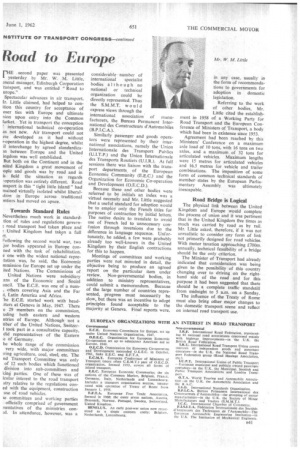Road to Europe
Page 109

If you've noticed an error in this article please click here to report it so we can fix it.
HE second paper was presented 1 yesterday by Mr. W. M. Little, meral manager, Edinburgh Corporation ransport, and was entitled "Road to urope."
Spectacular advances in air transport, Ir. Little claimed, had helped to conition this country for acceptance of oser ties with Europe and ultimate lion upon entry into the Common larket. Yet in transport the conception ! international technical co-operation as not new. Air transport could not ive developed as it had without i-operation in the highest degree, whilst il interchange by agreed standardizam between Europe and the United ingdom was well established.
But both on the Continent and in the nited Kingdom a great movement of ,ople and goods was by road and in is field the situation as regards -operation was entirely different. Road insport in this "tight little island" had mined virtually isolated whilst liberalttion in Europe across traditional mtiers had moved on apace.
Towards Standard Rules
Nevertheless much work in standard.tion of rules and regulations governroad transport had taken place and I United Kingdom had taken a full rt.
Following the second world war, two jor bodies appeared in Europe conned with the task of rehabilitation. e one with the widest national repretation was, he said, the Economic mrnission for Europe set up under the ited Nations. The Commissions of United Nations were subsidiary ans of the Economic and Social ancil. The E.C.E. was one of a num, others covering Asia and the Far t, Latin America and Africa.
ite E.C.E. started work with head.rters at Geneva in May, 1947. There e 29 members on the commission, uding both eastern and western ntries of Europe. Although not a nber of the United Nations, SwitzerI took part in a consultative capacity, did representatives of the Eastern ,e of Germany.
he whole range of the commission very wide, with major committees ;ring agriculture, coal, steel, etc. The nd Transport Committee was only of 12 such bodies which functioned division into sub-committees and king parties. One of these was of icuIar interest to the road transport stry relative to the regulations coned with the equipment, construction use of road vehicles.
le committees and working parties officially comprised of government ;sentatives of the ministries con;.(1. In attendance, however, was a considerable number of international specialist bodies although no national or technical organization could be directly represented. Thus the S.M.M.T. would express views through the international association of manufacturers, the Bureau Permanent International des Constructeurs d'Auto mobiles (B.P.I.C.A.).
Similarly passenger and goods operators were represented by their international associations, namely the -Union Internationale des Transport Publics (U.I.T.P.) and the Union Internationale des Transports Routiers (U.1.R.). At full sessions there was liaison with the transport departments, of the European Economic Community (E.E.C.) and the Organization for Economic Co-operation and Development (0.E.C.D.).
Because these and other bodies were referred to by initials an index was a virtual necessity and Mr. Little suggested that a useful standard for adoption would be to employ only the French titles for purposes of contraction by initial letters. The native desire to translate to avoid use of French led to unnecessary confusion through inversions due to the difference in language sequence. Unfortunately, he added, a few were probably already too well-known in the United Kingdom by their English contractions for this to happen.
Meetings of committees and working parties were not minuted in detail, the objective being to produce an agreed report on the particular item under review. Non-governmental bodies, in addition to ministry representatives, could submit a memorandum. Because of the large number of countries represented, progress must necessarily be slow, but there was an incentive to adopt principles found acceptable to the majority at Geneva_ Final reports were, in any case, usually in the form of recommendations to governments for adoption in domestic legislation.
Referring to the work of other bodies, Mr. Little cited the establishment in 1958 of a Working Party for Road Transport and the European Conference of Ministers of Transport, a body which had been in existence since 1953.
Agreement had been reached by this Ministers' Conference on a maximum axle load of 10 tons, with 16 tons on two axles, and a maximum of 32 tons for articulated vehicles. Maximum lengths were 15 metres for articulated vehicles and 16.5 metres for vehicle and trailer combinations. The imposition of some form of common technical standards of member states by the European Parliamentary Assembly was ultimately inescapable.
Road Bridge is Logical
The physical link between the United Kingdom and Europe would complete the process of union and it was pertinent that in the United Kingdom five times as much was carried by road as by rail. Mr. Little asked, therefore, if it was not unrealistic to consider any form of link not primarily designed for road vehicles. With motor taxation approaching £700m. annually, technical feasibility of a bridge should be the only criterion.
The Minister of Transport had already indicated that consideration was being given to the possibility of this country changing over to driving ort the righthand side of the road and for this purpose it had been suggested that there should be a complete traffic standstill from midnight to 5 a.m. on a Sunday.
The influence of the Treaty of Rome must also bring other major changes to the domestic transport scene and reflect on internal road transport use.






































































































































































